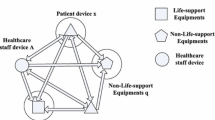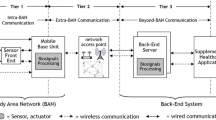Abstract
Efficient computation of quality of service (QoS) during medical data processing through intelligent measurement methods is one of the mandatory requirements of the medial healthcare world. However, emergency medical services often involve transmission of critical data, thus having stringent requirements for network quality of service (QoS). This paper contributes in three distinct ways. First, it proposes the novel adaptive QoS computation algorithm (AQCA) for fair and efficient monitoring of the performance indicators, i.e., transmission power, duty cycle and route selection during medical data processing in healthcare applications. Second, framework of QoS computation in medical applications is proposed at physical, medium access control (MAC) and network layers. Third, QoS computation mechanism with proposed AQCA and quality of experience (QoE) is developed. Besides, proper examination of QoS computation for medical healthcare application is evaluated with 4–10 inches large-screen user terminal (UT) devices (for example, LCD panel size, resolution, etc.). These devices are based on high visualization, battery lifetime and power optimization for ECG service in emergency condition. These UT devices are used to achieve highest level of satisfaction in terms, i.e., less power drain, extended battery lifetime and optimal route selection. QoS parameters with estimation of QoE perception identify the degree of influence of each QoS parameters on the medical data processing is analyzed. The experimental results indicate that QoS is computed at physical, MAC and network layers with transmission power (− 15 dBm), delay (100 ms), jitter (40 ms), throughput (200 Bytes), duty cycle (10%) and route selection (optimal). Thus it can be said that proposed AQCA is the potential candidate for QoS computation than Baseline for medical healthcare applications.














Similar content being viewed by others
References
Eidenberger H (2012) Handbook of multimedia information retrieval: “the common methods of audio retrieval, biosignal processing, content-based image retrieval, face, text retrieval and video surveillance”. Austria
Dimitrov DV (2016) Medical internet of things and big data in healthcare. Healthc Inform Res 22(3):156–163
Reichl P, Egger S (2015) Towards a comprehensive framework for QoE and user behavior modeling. In: 7th international workshop on quality of multimedia experience
ITU-T G 107 (2015) The e-model, a computational model for use in transmission planning. Geneva
Sodhro AH, Pirbhulal S (2018) Power control algorithms for media transmission in remote healthcare systems. IEEE Access 6(1):1–8
Awobuluyi O, Nightingale J (2015) Video quality in 5G networks: context-aware QoE management in the SDN control plane. In: IEEE international conference on computer and IT
Chihani B, Laghari KR (2013) User-centric quality of experience measurement. In: International conference on mobile computing, applications and services. pp 33–46
Yaacoub E, Dawy Z (2014) Fair optimization of video streaming quality of experience in LTE networks using distributed antenna systems and RRM. J Appl Math 2014(2014):1–12
Chen X, Hwang J-N (2015) A near optimal QoE-driven power allocation scheme for scalable video transmissions over MIMO systems. IEEE J Sel Top Signal Process 9(1):76–88
Wang L, An N (2013) Power-aware wireless communication system design for body area networks. E Health Telecommun Syst Netw (ETSN) J 2(2):23–28
Yaacoub E, Filali F (2015) Enhancement of SVC video streaming over vehicular networks using cooperative LTE/802.11p Comm. IEEE J Sel Top Signal Process 9(1):37–49
Sodhro AH, Zongwei L (2018) Mobile edge computing based QoS optimization in medical healthcare applications. Int J Inf Manag (IJIM) 18:1–21
Chen C, Zhu X (2015) Rate adaptation and admission control for video transmission with subjective quality constraints. IEEE J Sel Top Signal Process 9(1):22–36
Xu D, He C, Li Y (2013) Improving quality of experience in M-health monitoring system. In: 35th annual international conference of the IEEE EMBS Osaka, Japan
Li Y, Qiao D, Xu Z, Xu D, Miao F (2012) Energy-model-based optimal communication systems design for wireless sensor networks. Int J Distrib Sens Netw 2012(2012):1–11
Sodhro AH, Pirbhulal S, Sodhro GH, Gurtov A, Muzammal M, Luo Z (2018) A joint transmission power control and duty-cycle approach for smart healthcare system. IEEE Sens J 99:1–8
Goldberger AL, Amaral LAN (2000) PhysioBank, PhysioToolkit, and PhysioNet: components of a new research resource for complex physiologic signals. Circulation 101(23):215–220
Doutre MC, Nasiopoulos P (2012) Rendering 3-D high dynamic range images: subjective evaluation of tone-mapping methods and preferred 3-D image attributes. IEEE J Sel Top Signal Process 6(5):597–610
Martini MG, Chen CW, Zhu X (2012) QoE-awarewireless multimedia systems. IEEE J Sel Areas Commun 30(7):53–56
Sodhro AH, Pirbhulal S (2018) Convergence of IoT and product lifecycle management in medical health care. Future Gener Comput Syst 86(2018):380–391
Ojanper T, Uitto M (2014) QoE-based management of medical video transmission in wireless networks. In: IEEE/IFIP network operations and management symposium
Laghari KUR, Pham TT, Nguyen H, Crespi N (2012) QoM: a new quality of experience framework for multimedia services. In: IEEE symposium on computers and communications (ISCC)
Wen Y, Zhu X, Rodrigues JJPC (2014) Cloud mobile media: reflections and outlook. IEEE Trans Multimedia 16(4):885–901
Sodhro AH, Pirbhulal S, Sodhro GH (2018) An energy-efficient algorithm for wearable electrocardiogram signal processing in ubiquitous 3 healthcare applications. MDPI Sens 8(3):923
Xu Y, Zhao X (2014) Robust power control for underlay cognitive radio networks under probabilistic quality of service and interference constraints. IET Commun 8(18):3333–3340
Kang J-W, Hussain A, Kim S-H et al (2015) Link scheduling schemes with on–off interference map for device to device communications. IET Commun 9(3):359–366
Dai Z, Liu J, Wang C et al (2015) QoS-based device to device communication schemes in heterogeneous wireless networks. IET Commun 9(3):335–341
Sodhro AH, Shaikh FK, Pirbhulal S, Lodro MM, Shah MA (2017) Medical-QoS based telemedicine service selection using analytic hierarchy process. In: Khan SU, Zomaya AY, Abbas A (eds) Handbook of large-scale distributed computing in smart healthcare. Springer, Cham, pp 589–609
Kim HJ et al (2014) QoE assessment model for multimedia streaming services using QoS parameters. J Multimedia Tools Appl 72(2014):2163–2175
Pal D, et al (2017) Effect of network QoS on user QoE for a mobile video streaming services using H.265/VP9 Codec. In: 8th international conference on advances in information technology (IAIT2016), vol 111(2017), pp 214–222
Sodhro AH, Sekahri A, Ouzrout Y (2018) Energy-efficiency comparison between data rate control and transmission power control algorithms for wireless body sensor networks. Int J Distrib Sens Netw (IJDSN) 14(1):1–18
Floris A et al (2016) Managing the quality of experience in the multimedia internet of things: a layered-based approach. MDPI Sens 16(12):1–21
Mahmud R, et al (2018) Cloud-fog interoperability in IoT-enabled healthcare solutions, ICDCN’18, January 4–7, pp 1–10
Li Y (2017) Edge computing-based access network selection for heterogeneous wireless networks. Networking and Internet Architecture [cs.NI]. Université Rennes 1
Jridi M et al (2018) SoC-based edge computing gateway in the context of the internet of multimedia things: experimental platform. J. Low Power Electron Appl 8(1):1
Rahbari D, et al (2018) Scheduling of fog networks with optimized knapsack by symbiotic organisms search. In: Proceeding of the 21st conference of FRUCT association. pp 1–6
Gomes SL, de Rebouças ES, Neto EC, Papa JP, de Albuquerque VHC (2017) Embedded real-time speed limit sign recognition using image processing and machine learning techniques. Neural Comput Appl 35(1):573–584
Sodhro AH, Pirphulal S, Sekhari A, Ouzrout Y (2018) Green media-aware medical IoT system. Multimedia Tools Appl. https://doi.org/10.1007/s11042-018-5634-0
de Albuquerque VHC (2018) Robust automated cardiac arrhythmia detection in ECG beat signals. Neural Comput Appl 29(3):679–693
Rebouças Filho PP, da Silva Barros AC, Ramalho GLB, Pereira CR, Papa JP, de Albuquerque VHC (2017) Automated recognition of lung diseases in CT images based on the optimum-path forest classifier. Neural Comput Appl 27(1):1–14
Rodrigues JJPC, Segundo DBDR (2018) Enabling technologies for the internet of health things. IEEE Access 6(2018):13129–13141
da Cruz MAA, Rodrigues JJPC, Al-Muhtadi J (2018) A reference model for internet of things middleware. IEEE Internet of Things J 5(2):871–883
Lakshmanaprabu SK, Shankar K, Khanna A, Gupta D (2018) Effective features to classify big data using social internet of things. IEEE Access 6(2018):24196–24204
Sodhro AH, Pirbhulal S, Sodhro GH (2018) ‘5G-based transmission power control mechanism in fog computing for IoT devices. MDPI Sustain 10(4):1–17
Moraes JL, Rocha MX, Vasconcelos GG, Vasconcelos Filho JE (2018) Advances in photopletysmography signal analysis for biomedical applications. Sensors 18(6):1–20
Hussein AF, Kumar A, Burbano-Fernandez M (2018) An automated remote cloud-based heart rate variability monitoring system. IEEE Access 6:1–10
Pirbhulal S, Zhang H, Alahi MEE, Ghayvat H, Mukhopadhyay SC, Zhang Y-T et al (2016) A novel secure IoT-based smart home automation system using a wireless sensor network. Sensors 17:69
Wanqing Wu, Pirbhulal S (2015) Assessment of biofeedback training for emotion management through wearable textile physiological monitoring system. IEEE Sens J 15(12):7087–7095
Acknowledgements
This work is partially supported by Natural Science Foundation of China 6171101169, National Key R&D Plan-Key Special Plan on Public Security Risk Mitigation/Response 2017YFC0804003, Technologies and Equipment Guangdong Education Bureau Fund 2017KTSCX166, the Science and Technology Innovation Committee Foundation of Shenzhen JCYJ20170817112037041, Science and Technology Innovation Committee Foundation of Shenzhen (Grant No. ZDSYS201703031748284). Also for this research, Andrei Gurtov was supported by the Center for Industrial Information Technology (CENIIT) Project 17.01. This work is supported in part by the HEC Pakistan under the START-UP RESEARCH GRANT PROGRAM (SRGP)#21-1465/SRGP/R&D/HEC/2016, and Sukkur IBA University, Sukkur, Sindh, Pakistan.
Author information
Authors and Affiliations
Corresponding author
Ethics declarations
Conflict of interest
There is no conflict of interest between all authors.
Additional information
Publisher's Note
Springer Nature remains neutral with regard to jurisdictional claims in published maps and institutional affiliations.
Rights and permissions
About this article
Cite this article
Sodhro, A.H., Malokani, A.S., Sodhro, G.H. et al. An adaptive QoS computation for medical data processing in intelligent healthcare applications. Neural Comput & Applic 32, 723–734 (2020). https://doi.org/10.1007/s00521-018-3931-1
Received:
Accepted:
Published:
Issue Date:
DOI: https://doi.org/10.1007/s00521-018-3931-1




